This gluten-free pasta recipe makes perfect fresh lasagna sheets or hand-cut pasta. You can also roll the dough thicker for fresh noodles that are fabulous in chicken soup or braised beef and noodles.
How to make gluten-free pasta the easiest way: the food processor

Making gluten-free pasta is probably easier than you think, especially if you use a food processor. I started making fresh pasta at the insistence of my friend Shauna, author of the Gluten-Free Girl cookbooks (my favorite is this one) several years ago. This recipe is actually my version of the one she shared with me back then.
I've included directions for making the pasta by hand or in a food processor. Either way, the results are tender and delicious. This recipe my favorite for lasagna and hand-cut noodles. If you want to make fresh spaghetti or run your pasta through a smaller shape in a pasta machine, try this recipe from Alison Needham instead.
How to choose a gluten-free flour blend for fresh pasta:

Which gluten-free flour blend you choose is super important for fresh pasta. You’ll definitely want a blend that contains some starch, like tapioca, corn, arrowroot or potato starch, and one that has a light, all-purpose body, that contains flours made from rice, sweet rice, brown rice, or sorghum. I wouldn’t use a blend made with nut flour to make fresh pasta, at least until you've gotten the hang of it and understand the textures. I would not use a blend that contains bean flours at all, as they can be heavy and change the flavor of the pasta subtainally. You can use a blend that contains xanthan or guar gum to begin with, but you should definitely use psyllium husk powder or gum-free binder in the recipe as described.
Flour + climate will affect you gluten-free pasta dough:

The climate of where you're cooking, the moisture in the flour you're using, and the amount of hydration your gluten-free flour blend can absorb will all affect the outcome of your pasta dough. You may need more liquid ingredients in hot, dry weather than you will in wintertime. You might need more flour in a humid area, or if you store your flour in the freezer. The size of your eggs will also make a difference.
If your dough is too wet or too dry, don't freak out - this recipe is pretty forgiving. Just add more oil, water or flour, like the recipe suggests. Once you've rested the dough, the moisture will balance out.
Time to make those gluten-free lasagna sheets or noodles!
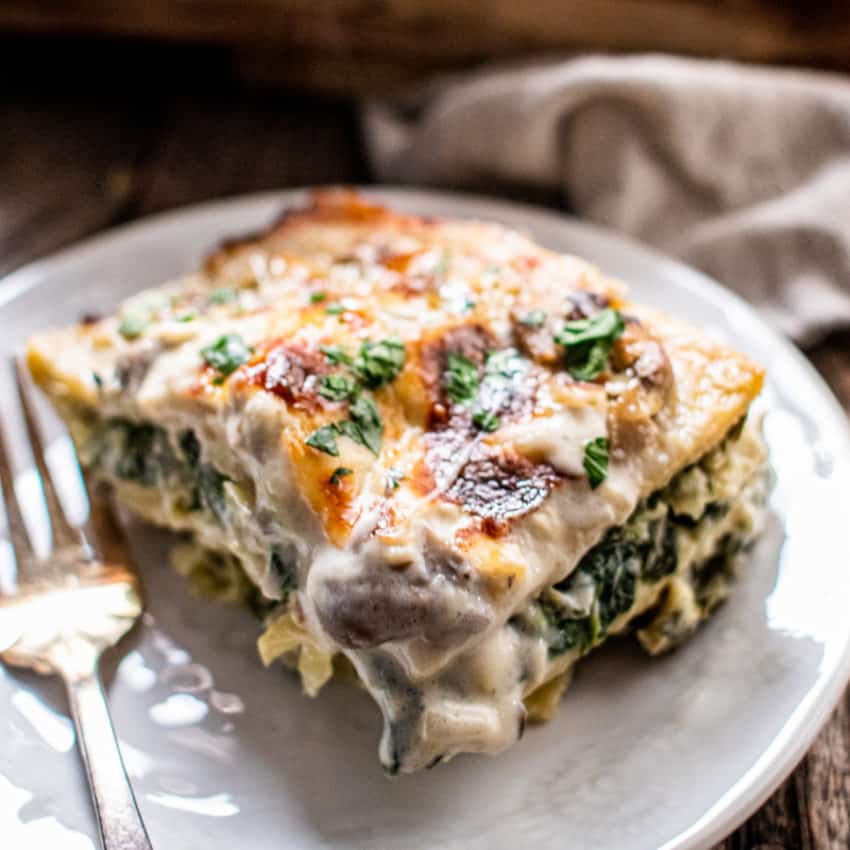
Now you're ready to make your own pasta!
Try it in this White Lasagna With Mushrooms, Spinach And Artichokes, or my mom's Traditional Meat Lasagna recipe. You could also whip up a batch of this super-easy Simple Walnut Pesto or try my friend Aida's Handkerchief Pasta with Silky Pesto.
Please share your finished fresh pasta with me on Instagram or Facebook, I can't wait to see your results!
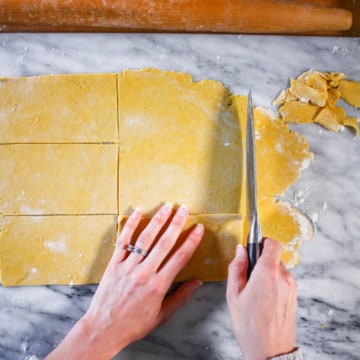
Fresh Gluten-Free Pasta Recipe
Ingredients
- 6.5 ounces gluten-free all-purpose flour blend plus more for rolling, or adding if the dough is too wet
- 1 teaspoon psyllium husk powder or gum-free baking binder
- 1 pinch ground nutmeg freshly grated, if you can
- ¾ teaspoon fine sea salt
- 2 large eggs
- 2 egg yolks from large eggs (if I'm making lasagna, I add the remaining whites to my cheese filling mixture)
- 1 to 2 tablespoons extra-virgin olive oil
- 1 to 2 tablespoons water
Instructions
Making the dough in the food processor.
- Add the flour, psyllium powder or binder mix, nutmeg, and salt in the bowl of the food processor and pulse 2-3 times to combine.
- Whisk together eggs, egg yolks, 1 tablespoon of the olive oil and 1 tablespoon of the water. Add the liquid to the flours.

- Pulse 8 -10 times, then look at the dough. If the dough has formed crumbs that look like small dry cheese curds (like baby peas), you’re done. If they are a little too dry or too small, add the remaining tablespoon of olive oil, then pulse 2-3 times and take another look. If it's still dry, add another tablespoon of water, if necessary (I've rarely had to do this). If the dough looks a bit too wet, add 2 tablespoons of flour and pulse 2-3 times. Then add 1 tablespoon at a time until you reach the right consistency.

- Turn out onto a dry, clean surface and shape into a ball.

Making the dough by hand.
- Combine the flours, psyllium powder or binder mix, nutmeg, and salt in a bowl. Whisk them together for a few moments to combine and aerate the flours.
- Pile the flours into a small mound on a clean, dry surface and make a well in the center - I use a large cutting board.
- Whisk the eggs, egg yolks, 1 tablespoon of the olive oil and 1 tablespoon of the water. Pour the liquid into the well in the center of the flour.

- Using a fork, rubber spatula, or your fingers, stir the liquids gently, bringing in a bit of flour from the outside walls with each turn. When most of the egg mixture is blended with the flour, bring the rest of the flour into the middle with your hands. If it feels too dry — flour flaking off the ball of dough — add the remaining olive oil, then water. If the dough feels too wet — if it squelches when it touches the board — add another tablespoon of flour.

- Take a few moments to knead the dough, gently. Push forward on the ball of dough with your hand, then fold the ball back on itself toward you. Rotate the dough and repeat until the dough feels supple and smooth.
Next Steps:
- Once you have your ball of dough, wrap it up completely in plastic wrap. Let it sit for 30-45 minutes at room temperature. When I'm making lasagna, this is when I grease my pan, preheat the oven and mix up my filling.

- Start a large pot of salted water on high heat on the stove to cook the fresh pasta. Cover the pot so the water is ready when you are.

- Spread a little flour on your favorite work surface. Cut the rested ball of pasta dough into two equal pieces. Shake a bit of flour over the top of the dough. Working gently, roll out the dough, backwards and forwards, side to side, until it is thin but not transparent.

- Using a sharp knife, cut the pasta into noodles of your desired size. Move the noodles onto a plate or seperate board. For lasagna, I cut the noodles half the width and length of the pan I'm using, which makes them easier to cook and arrange.

- Allow the pasta to rest at least 10 minutes after it's cut. Letting it rest while you're rolling and cutting the rest of the dough is fine - I usually just cook the pasta in the order I've rolled and cut it in.
- You're ready to cook the pasta! When the water is boiling, gently nudge your noodles into the water and cook until they are soft but still have a bit of a bite, about 2 to 3 minutes. (Don’t overcrowd the pan. You might have to cook this in 2 batches.) Drain immediately, reserving a bit of the cooking water for any sauce you might be making for hand-cut noodles. For lasagna, I drain the pasta on a baking rack laid over a cookie sheet so I can keep the noodles flat.

*To roll the pasta with a pasta machine:
- If you have a pasta machine, roll out the ball of dough to an oval about 3 inches long and 3 inches wide. Then, put the pasta through the rollers, starting at the first setting, then moving up until the dough is as thin as you desire and not breaking. Continue with the cooking steps above.
Notes

Nutrition

Now that you've got pasta, let's talk Homemade Lasagna.
Once your pasta is ready to go, you can tackle my mom's fabulous homemade lasagna recipe. You can make your own Meat Sauce too!
Kale + Sweet Potato Veggie Lasagna:
Un-fussy comfort food at its best. This veggie lasagna gluten-free recipe packs vegetables, cheese and decadent flavor into the perfect fall dinner.
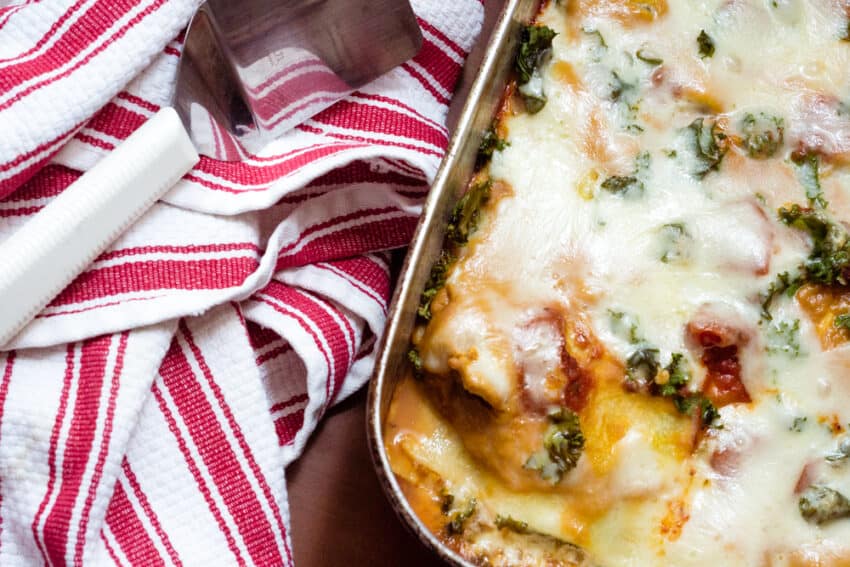
Frequently Asked Questions about this Gluten-Free Pasta Recipe:
I like to use Pamela's Gluten-Free Artisan Blend or King Arthur Measure for Measure blend to make fresh pasta. I've also used my own gluten-free flour blend with success, mixed with an extra ½ teaspoon of binder.
In a word: YES. You could use xanthan gum or guar gum instead, but it will alter the texture of the pasta, making it gummier (shocker) and sticky. You need a binder of some kind.
You can easily substitute medium or extra large eggs in this recipe. If you use medium, you may need to add a little oil or water as the recipe suggests. If you eggs are extra large, you may need a bit more flour.
Add more flour, 1 tablespoon at a time until you reach the consistency described in the recipe.
What should I do? Add more flour to the surface you're rolling the dough out on, on top of the dough, and dust your rolling pin with flour.

Gluten-Free Pasta Recipe Photos: Meg van der Kruik



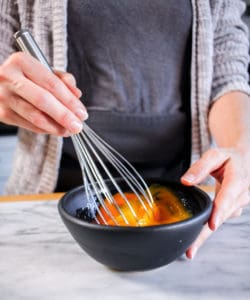











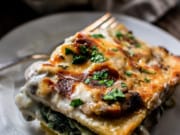


Nicole says
I’m trying this soon for lasagna!
K.C. Cornwell says
I hope you love it!
Kathy Burke says
Do you have to boil the noodles if making lasagna? If the sauce is wet enough, do you think these would be ok just layered in without boiling first?
K.C. Cornwell says
I would boil them, yes.
Victoria says
K.C., I've been researching g-free lasagna noodle recipes for a favorite seafood lasagna of mine, and I am especially drawn to your noodle recipe. Do you have experience with making the lasagna (making the g-free noodles, then layering the noodles and the filling, and then putting the dish in the fridge) the day before it will be baked? Does this affect how well the noodles will hold up? Also, could one make just the noodles the day before one puts the lasagna together to bake it? If so, would it be best to store the boiled noodles flat in the fridge, separated by wax/parchment paper, and then wrapped with cling film? I would really appreciate your advice.
K.C. Cornwell says
I would prepare the whole lasagna and refrigerate, rather than trying to store just the prepared noodles.
April says
havebyou tried freezing the lasagne to meal prep? I will be making one fresh but would like to freeze a couple so I have instant lasagne later. I have done this plenty of time with traditional regular premade dry pasta, but not gluten free and never made fresh noodles before. thanks
K.C. Cornwell says
Yes, you can definitely freeze these noodles within a prepared lasagna and thaw & bake later. I do it often.